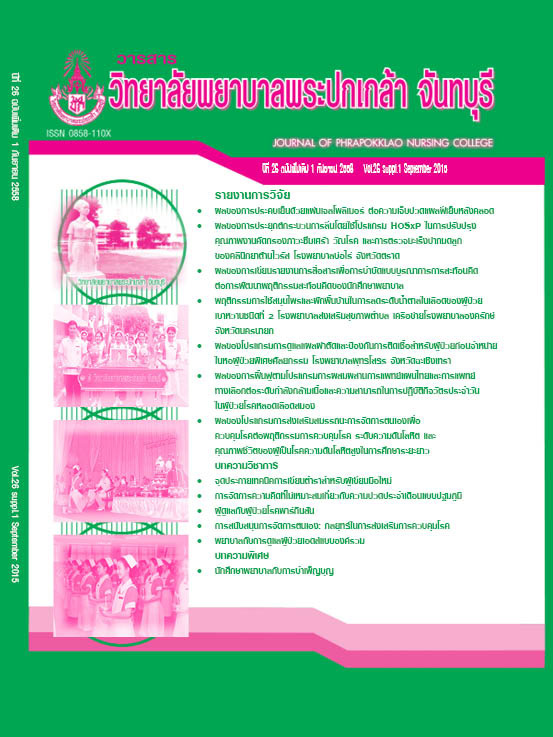ผลของโปรแกรมการส่งเสริมสมรรถนะการจัดการตนเองเพื่อควบคุมโรคต่อพฤติกรรมการควบคุมโรค ระดับความดันโลหิต และคุณภาพชีวิตของผู้เป็นโรคความดันโลหิตสูงในการศึกษาระยะยาว
คำสำคัญ:
โปรแกรมการส่งเสริมสมรรถนะการจัดการตนเองเพื่อควบคุมโรค, พฤติกรรมการควบคุมโรค, ระดับความดันโลหิต, คุณภาพชีวิต, ผู้เป็นโรคความดันโลหิตสูงบทคัดย่อ
การวิจัยครั้งนี้เป็นการวิจัยเชิงทดลองทางคลินิก เพื่อศึกษาผลของโปรแกรมการส่งเสริมสมรรถนะการจัดการตนเองเพื่อควบคุมโรคต่อพฤติกรรมการควบคุมโรค ระดับความดันโลหิต และคุณภาพชีวิตของผู้เป็นโรคความดันโลหิตสูง ในกลุ่มตัวอย่างจำนวน 255 คน ที่มีสิทธิประกันสุขภาพและอาศัยอยู่ในเขตจังหวัดปทุมธานีและจังหวัดใกล้เคียง ที่มารับบริการ ณ ศูนย์การแพทย์คูคต สาขาลำลูกกา 21 และสาขาเซียร์ รังสิต อำเภอลำลูกกา จังหวัดปทุมธานี สุ่มกลุ่มตัวอย่างเข้ากลุ่มทดลองและกลุ่มควบคุมด้วยวิธีการสุ่มอย่างง่าย กลุ่มทดลองได้รับการรักษาตามแนวทางการรักษาของราชวิทยาลัยอายุรแพทย์แห่งประเทศไทย การติดตามเยี่ยมบ้านโดยพยาบาลฝ่ายส่งเสริมสุขภาพ และได้รับโปรแกรมการส่งเสริมสมรรถนะการจัดการตนเองเพื่อควบคุมโรค ส่วนกลุ่มควบคุมได้รับการรักษาตามแนวทางการรักษาของราชวิทยาลัยอายุรแพทย์แห่งประเทศไทย และการติดตามเยี่ยมบ้านโดยพยาบาลฝ่ายส่งเสริมสุขภาพ เครื่องมือที่ใช้ในการวิจัยประกอบด้วยโปรแกรมการส่งเสริมสมรรถนะการจัดการตนเองเพื่อควบคุมโรค คู่มือการจัดการตนเอง เรื่อง “อยู่อย่างเป็นสุขกับโรคเรื้อรัง” เก็บรวบรวมข้อมูลด้วยเครื่องวัดความดันโลหิต แบบประเมินพฤติกรรมการควบคุมโรค และแบบวัดคุณภาพชีวิตฉบับภาษาไทย ที่มีค่าความเชื่อมั่น .91 และ .93 ตามลำดับ ดำเนินการทดลองและเก็บรวบรวมข้อมูลในช่วงเดือนมิถุนายน 2552 ถึงเดือนกรกฎาคม 2553 วิเคราะห์ข้อมูลด้วยสถิติความถี่ ร้อยละ ค่าเฉลี่ย ส่วนเบี่ยงเบนมาตรฐาน independent t-test การทดสอบไคสแควร์ และ repeated measure ANOVA โดยทดสอบความแตกต่างเป็นรายคู่ด้วยวิธี Bonferroni
ผลการวิจัยพบว่า 1) หลังการทดลอง 6 เดือน กลุ่มทดลองมีค่าเฉลี่ยพฤติกรรมการควบคุมโรคและค่าเฉลี่ยคุณภาพชีวิตดีกว่าก่อนการทดลองอย่างมีนัยสำคัญทางสถิติ (p < .05) โดยมีระดับความดันโลหิตซิสโตลิกและไดแอสโตลิกไม่แตกต่างจากก่อนการทดลองอย่างมีนัยสำคัญทางสถิติ 2) หลังการทดลอง 12 เดือน กลุ่มทดลองมีค่าเฉลี่ยพฤติกรรมการควบคุมโรค ค่าเฉลี่ยคุณภาพชีวิต และระดับความดันโลหิตซิสโตลิก ไม่แตกต่างจากก่อนการทดลองอย่างมีนัยสำคัญทางสถิติ แต่มีระดับความดันโลหิตไดแอสโตลิกต่ำกว่าก่อนการทดลองอย่างมีนัยสำคัญทางสถิติ (p < .05) 3) หลังการทดลอง 6 เดือน กลุ่มทดลองมีค่าเฉลี่ยพฤติกรรมการควบคุมโรคและค่าเฉลี่ยคุณภาพชีวิตดีกว่ากลุ่มควบคุมอย่างมีนัยสำคัญทางสถิติ (p < .001 และ p < .05 ตามลำดับ) และมีระดับความดันโลหิตไดแอสโตลิกต่ำกว่ากลุ่มควบคุมอย่างมีนัยสำคัญทางสถิติ (p < .05) แต่มีระดับความดันโลหิตซิสโตลิกไม่แตกต่างจากกลุ่มควบคุม และ 4) หลังการทดลอง 12 เดือน กลุ่มทดลองมีค่าเฉลี่ยพฤติกรรมการควบคุมโรคและค่าเฉลี่ยคุณภาพชีวิตดีกว่ากลุ่มควบคุมอย่างมีนัยสำคัญทางสถิติ (p < .001) และมีระดับความดันโลหิตไดแอสโตลิกต่ำกว่ากลุ่มควบคุมอย่างมีนัยสำคัญทางสถิติ (p < .05) แต่มีระดับความดันโลหิตซิสโตลิกไม่แตกต่างจากกลุ่มควบคุม
จากการวิจัยครั้งนี้มีข้อเสนอแนะว่าในการศึกษาระยะยาว ควรมีการกระตุ้นติดตามเป็นระยะ เพื่อเพิ่มประสิทธิผลของโปรแกรม และควรควบคุมปัจจัยที่มีอิทธิพลต่อความดันโลหิตในการศึกษาระยะยาว
เอกสารอ้างอิง
กรมควบคุมโรค กระทรวงสาธารณสุข. (2551). รายงานผลการสำรวจพฤติกรรมเสี่ยงโรคไม่ติดต่อและการบาดเจ็บ พ.ศ. 2550. กรุงเทพฯ: โรงพิมพ์องค์การสงเคราะห์ทหารผ่านศึก.
ชดช้อย วัฒนะ, สุธน พรธิสาร, ณฐวรรณ รักวงศ์ประยูร, และปริญญา แร่ทอง. (2550). ผลของโปรแกรมการส่งเสริมสมรรถนะในการจัดการตนเองเกี่ยวกับโรคเบาหวานต่อความรู้ การรับรู้สมรรถนะในการจัดการตนเอง การควบคุมระดับน้ำตาลในเลือด ค่าดัชนีมวลกาย และคุณภาพชีวิตของผู้ป่วยเบาหวานชนิดที่ 2 (รายงานผลการวิจัย). คณะพยาบาลศาสตร์ มหาวิทยาลัยธรรมศาสตร์.
นวลจันทร์ ดิเรกวุฒิกุล. (2552). ภาวะความดันโลหิตสูงที่ไม่สามารถควบคุมได้ตามการรับรู้ของผู้ที่มีภาวะความดันโลหิตสูง (วิทยานิพนธ์ปริญญามหาบัณฑิต). ชลบุรี: มหาวิทยาลัยบูรพา.
ประเสริฐ อัสสันตชัย. (2552). ปัญหาสุขภาพที่พบบ่อยในผู้สูงอายุและการป้องกัน. กรุงเทพฯ: ยูเนี่ยนครีเอชั่น.
ผ่องพรรณ อรุณแสง. (2552). การพยาบาลผู้ป่วยโรคหัวใจและหลอดเลือด (พิมพ์ครั้งที่ 6). ขอนแก่น: โรงพิมพ์คลังนานาวิทยา.
ศรัญญา คล้ายสกุล. (2551). ผลของโปรแกรมการกำกับพฤติกรรมร่วมกับการปฏิบัติโยคะต่อความดันโลหิตและค่าดัชนีมวลกายในผู้ป่วยโรคความดันโลหิตสูงที่มีน้ำหนักตัวเกินมาตรฐาน (วิทยานิพนธ์ปริญญามหาบัณฑิต). กรุงเทพฯ: จุฬาลงกรณ์มหาวิทยาลัย.
ศิริวัฒน์ วงศ์พุทธคำ. (2551). ผลของการจัดการตนเองต่อพฤติกรรมสุขภาพและความดันโลหิตของผู้ป่วยความดันโลหิตสูง (วิทยานิพนธ์ปริญญามหาบัณฑิต). มหาวิทยาลัยเชียงใหม่.
สมาคมความดันโลหิตสูงแห่งประเทศไทย. (2551). แนวทางการรักษาโรคความดันโลหิตสูงในเวชปฏิบัติทั่วไป พ.ศ. 2551. สืบค้น วันที่ 8 ธันวาคม 2554, จาก http://www.thaihypertension.org/guideline.html
สุภัสษร ชมภู. (2551). ผลของโปรแกรมการจัดการตนเองต่อพฤติกรรมสุขภาพและความดันโลหิตในผู้ป่วยความดันโลหิตสูง (วิทยานิพนธ์ปริญญามหาบัณฑิต). ชลบุรี: มหาวิทยาลัยบูรพา.
Bandura, A. (1997). Self-efficacy: The exercise of control. New York: Freeman and Company.
Chase, N. L., Sui, X., Lee, D. C., & Blair, S. N. (2009). The association of cardiorespiratory fitness and physical activity with incidence of hypertension in men. American Journal of Hypertentions, 22(4), 417-424.
Chodosh, J., et al. (2005). Meta-analysis: Chronic disease self-management programs for older adults. Annals of Internal Medicine, 143(6), 427-438.
Creer, L. T. (2000). Self-management of chronic illness. In Boekaerts, M., Printrich, P. R., & Zeidner, M. (Eds.). Handbook of self-regulation. pp. 601-629. San Diego, CA: Academic Press.
Fisher, N., & Williams, G. (2005). Hypertensive vascular disease. In Kasper, D., Fauci, F., Longo, D., Braunwald, E., Hauser, S., & Jameson, J. L. (Eds.). Harrison’s principle of internal medicine. pp. 1463-1481. New York: McGraw Hill.
Lucini, D., Di Fede, G., Parati, G., & Pagani, M. (2005). Impact of chronic psychosocial stress on autonomic cardiovascular regulation in otherwise healthy subjects. Hypertension, 46(5), 1201-1206.
Norman, M., Victor, M., & Kaplan, R. G. (2009). Kaplan’s clinical hypertension. Lippincott: Williams & Wilkins.
Wattana, C. (2006). Effects of the diabetes self-management program on knowledge of diabetes, glycemic control, cardiovascular disease risk, and quality of life among people with type 2 diabetes (doctoral dissertation). Chiang Mai University.
Wexler, R., & Aukerman, G. (2006). Nonphamacologic strategies for managing hypertension. American Family Physician, 73(11), 1953-1956.
ดาวน์โหลด
เผยแพร่แล้ว
รูปแบบการอ้างอิง
ฉบับ
ประเภทบทความ
สัญญาอนุญาต
ลิขสิทธิ์ (c) 2015 วารสารวิทยาลัยพยาบาลพระปกเกล้า จันทบุรี

อนุญาตภายใต้เงื่อนไข Creative Commons Attribution-NonCommercial-NoDerivatives 4.0 International License.
เนื้อความ ข้อมูล และรายการอ้างอิงที่ผู้เขียนใช้ในการเขียนบทความเพื่อลงตีพิมพ์ในวารสารวิทยาลัยพยาบาลพระปกเกล้า จันทบุรี ถือเป็นความคิดเห็นและความรับผิดชอบของผู้เขียน คณะผู้จัดทำวารสารไม่จำเป็นต้องเห็นพ้องด้วยหรือร่วมรับผิดชอบ
บทความที่ได้รับการลงตีพิมพ์ในวารสารวิทยาลัยพยาบาลพระปกเกล้า จันทบุรี ถือเป็นลิขสิทธิ์ของวารสารวิทยาลัยพยาบาลพระปกเกล้า จันทบุรี หากหน่วยงานหรือบุคคลใดต้องการนำส่วนหนึ่งหรือทั้งหมดของบทความไปเผยแพร่ต่อเพื่อวัตถุประสงค์ใด ๆ จะต้องได้รับอนุญาตจากบรรณาธิการวารสารก่อน



